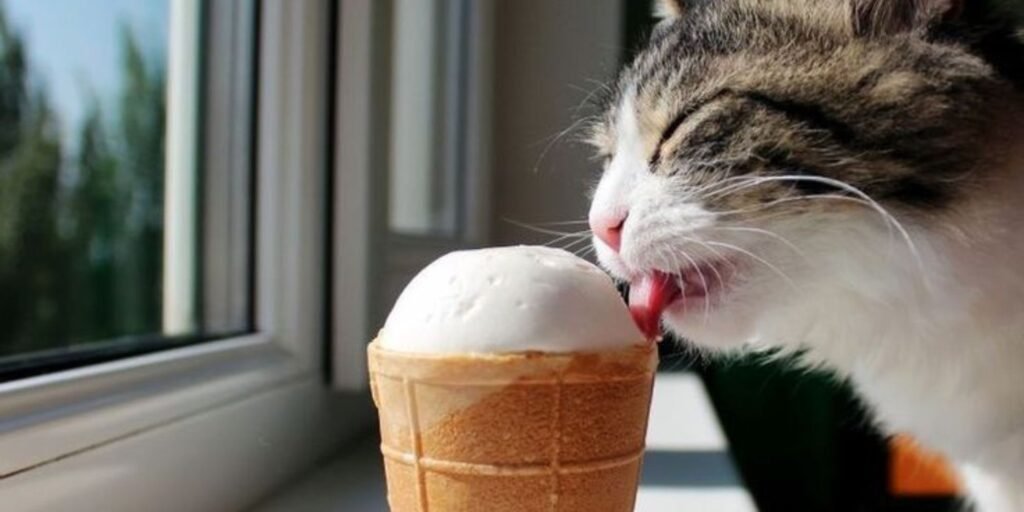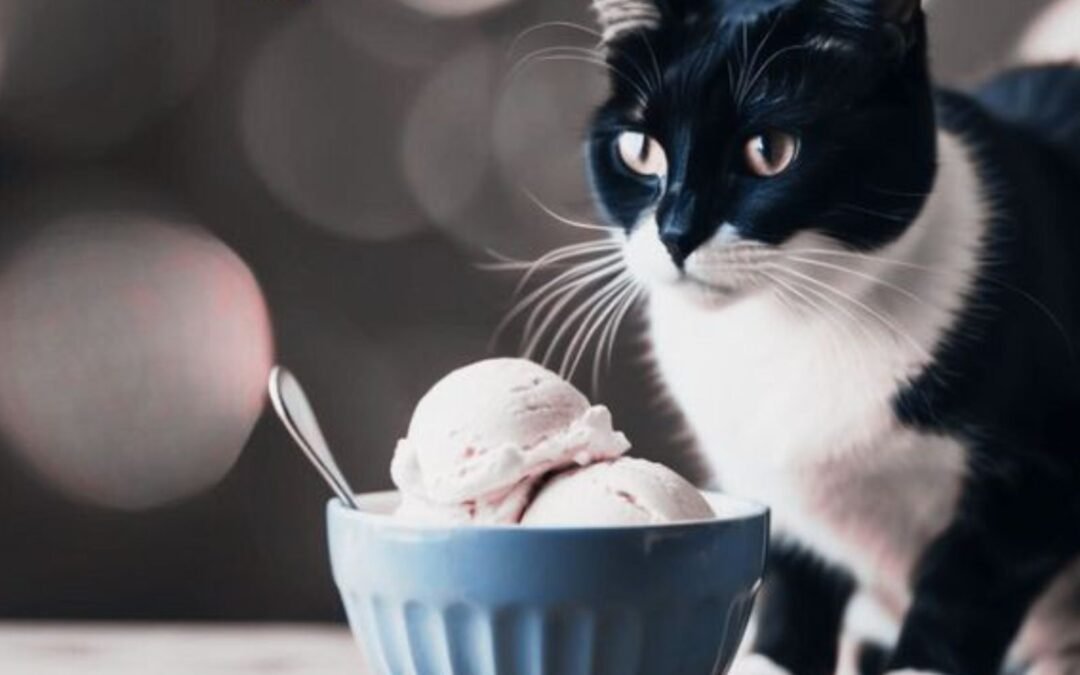When you’re savoring a scoop of your favorite ice cream on a hot day, sharing a spoonful with your furry feline friend can be tempting. After all, that soft purring and curious gaze are hard to resist. But before you do, it’s important to ask—can cats eat ice cream? While it might seem harmless to share, the answer is not as straightforward as you think.
This post will explore whether ice cream is safe for cats, the risks involved, and what alternative treats you can offer to show your cat some love.
Is Ice Cream Safe for Cats?
On the surface, you might think, “How bad could it be? It’s just milk, sugar, and flavoring.” While this may seem harmless, ice cream is far from an ideal or safe snack for your cat. Though it might not be outright toxic in small quantities, it can cause a variety of health problems for your feline friend. Let’s dive into the reasons why ice cream is not the best treat for cats:
Lactose Intolerance in Cats
The most important factor to consider is that most adult cats are lactose intolerant. While kittens can digest their mother’s milk, as they grow older, their ability to break down lactose diminishes significantly. This means that when adult cats consume dairy products like ice cream, they can experience digestive discomfort. Lactose intolerance can lead to several symptoms, including:
- Diarrhea: The body struggles to process the lactose, leading to loose stools.
- Vomiting: The digestive system may reject the dairy, resulting in vomiting.
- Bloating and Gas: The inability to break down lactose causes gas to build up, leading to discomfort and bloating.
For these reasons, offering ice cream to your cat can result in unpleasant digestive issues that are easily avoidable.
The Sugar Problem
Ice cream is packed with sugar, a substance that cats don’t need in their diet. Cats are obligate carnivores, meaning that their nutritional requirements are primarily fulfilled by meat, not carbohydrates or sugar. Their bodies are not equipped to process sugars efficiently, and consuming foods high in sugar can disrupt their natural diet. Over time, excess sugar can lead to serious health problems, including:
- Obesity: Sugar-rich treats can contribute to weight gain, which can lead to obesity in cats.
- Diabetes: High sugar intake can contribute to the development of diabetes, a condition that is increasingly common in overweight and poorly fed cats.
- Metabolic Imbalances: The imbalance of sugar in their system can affect various organs and bodily functions, ultimately leading to metabolic issues.
Given that cats have very specific dietary needs, it’s essential to avoid offering them sugary snacks like ice cream.
Toxic Ingredients in Ice Cream
Another significant concern is the potential for toxic ingredients in some ice creams. While plain vanilla ice cream may seem innocuous, some flavors and additives can be harmful to your cat. For instance, chocolate contains theobromine, a compound that is highly toxic to cats. Even small amounts of chocolate can cause symptoms such as restlessness, rapid heart rate, vomiting, and, in extreme cases, death.
In addition to chocolate, many ice creams contain artificial sweeteners like xylitol, which are extremely toxic to cats. Xylitol can cause a rapid drop in blood sugar, leading to symptoms such as seizures, liver failure, and even death. Other potential hazards in ice cream include raisins, macadamia nuts, and certain flavorings that can also pose serious health risks to cats.
Cold Sensitivity
Finally, cats are generally more sensitive to cold temperatures than humans. While you might enjoy a refreshing scoop of ice cream on a hot day, your cat might find it uncomfortable or even painful to consume something so cold. Cats often have more sensitive teeth and gums compared to humans, and biting into an icy treat can cause discomfort. This cold sensitivity can lead to reluctance to eat, or even short-term pain for your cat.
Conclusion: Stick to Safe Treats
While the idea of sharing a sweet, cold treat like ice cream with your cat may sound cute, it’s not recommended for their health and well-being. From digestive issues caused by lactose intolerance to the risks of toxic ingredients and sugar-related health problems, ice cream simply isn’t a suitable snack for cats. Instead, stick to cat-friendly treats that are specifically designed to meet their nutritional needs. Always prioritize your cat’s health, and when in doubt, consult with your veterinarian for safe and healthy treat alternatives.
Potential Health Risks of Feeding Ice Cream to Cats
While a small lick of plain vanilla ice cream might not cause immediate harm to your cat, regular feeding or larger portions can lead to the following issues:
- Digestive Upset
Due to lactose intolerance, even a small amount of ice cream can cause diarrhea or an upset stomach in cats.
- Obesity
Ice cream is calorie-dense and offers no nutritional benefit to cats. Over time, the excess calories from treats like ice cream can contribute to weight gain and obesity.
- Toxicity
If the ice cream contains harmful ingredients like chocolate or xylitol, your cat could experience symptoms ranging from vomiting to seizures or, in severe cases, even death.
- Behavioral Problems
Regularly giving human treats like ice cream to your cat can encourage begging behavior or lead your cat to associate your food as their own, making mealtime challenging.
Can cats eat ice cream :Healthier Alternatives to Ice Cream for Cats

If you want to indulge your cat with a cool, refreshing treat, there are safer and healthier options to explore:
- Cat-Friendly Ice Cream
Pet-specific ice cream products on the market are created just for cats. These are usually lactose-free and made with safe ingredients for feline consumption.
- Frozen Wet Cat Food
You can freeze small portions of wet cat food to create a feline-friendly frozen treat. Scoop some of their favorite wet food into an ice cube tray and freeze it.
- Plain, Unsweetened Yogurt
While most adult cats are lactose-intolerant, some can digest small amounts of plain, unsweetened yogurt, as it contains live cultures that help break down lactose. Always test with a tiny amount first to see how your cat reacts.
- Frozen Tuna Water
Drain the water from a can of tuna (in water, not oil) and freeze it into small cubes. Your cat will likely enjoy licking and playing with this safe and tasty treat.
- DIY Cat Treats
Plenty of recipes online for easy, homemade frozen treats you can make for your cat. These often combine cat-safe ingredients like pureed salmon or chicken with water or broth.
Can cats eat ice cream :How to Tell if Your Cat Has Eaten Ice Cream
Accidents happen. If your cat has managed to sneak a lick (or more) of your ice cream, here’s what you need to watch for:
Mild Symptoms
- Upset Stomach: Temporary issues like vomiting or diarrhea could occur due to lactose intolerance.
- Lethargy: Your cat may seem less active than usual.
Severe Symptoms (Seek Vet Attention Immediately)
- Tremors, Seizures, or Muscle Stiffness: This could indicate chocolate toxicity or poisoning due to harmful ingredients.
- Rapid Breathing or Drooling: This could be an allergic reaction or toxicity.
If you notice any of these severe symptoms, contact your veterinarian immediately.
Can cats eat ice cream :Wrapping It Up—Keep Ice Cream for Yourself

While it’s tempting to include your cat in your indulgent moments, ice cream isn’t worth the risk to their health. The high lactose content, sugar, and potentially toxic ingredients make it a poor choice for treatment. Instead, opt for cat-friendly alternatives that are safe and just as satisfying.
Remember, our pets rely on us to make the right dietary decisions for them—and part of loving them is keeping them healthy.
Want to know more about your cat’s diet or discover new ways to treat your feline friend? Subscribe to our newsletter for expert tips, or check out our recommendation for cat-friendly snacks!

